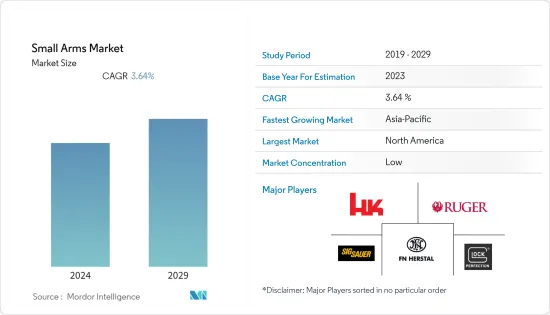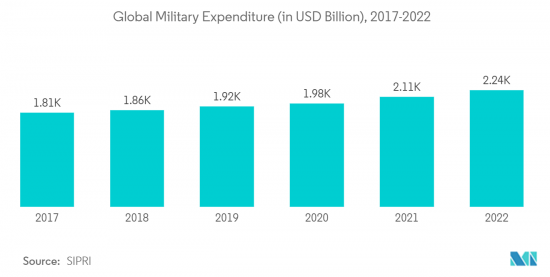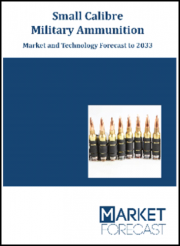
|
시장보고서
상품코드
1406913
소형 무기 : 시장 점유율 분석, 산업 동향과 통계, 성장 예측(2024-2029년)Small Arms - Market Share Analysis, Industry Trends & Statistics, Growth Forecasts 2024 - 2029 |
||||||
소형 무기 시장은 2024년 94억 3,000만 달러에서 2029년 112억 8,000만 달러로 증가할 것으로 예상되며, 예측 기간 동안 3.64%의 CAGR을 기록할 것으로 예상됩니다.

세계의 국방비 증가와 보병 장비 업그레이드 프로그램의 시작은 더 정교하고 더 많은 살상력을 가진 군용 소총의 조달을 촉진하고 있습니다. 또한 일부 국가는 가볍고 정밀한 차세대 소총을 자체 개발하는 데 주력하고 있습니다. 기술 발전은 이러한 개발을 촉진하고 있습니다. 반면, 개인 총기 구입을 엄격히 규제하는 국가도 있습니다. 최근 몇 년 동안 자살과 총기 난사 사건이 증가하면서 총기 규제가 강화되고 있습니다. 이러한 요인은 민간 부문 소형 총기 시장의 성장에 도전이 되고 있습니다.
소형 무기 시장 동향
예측 기간 동안 군사 부문은 여전히 우위를 유지할 것으로 전망
군사 부문은 예측 기간 동안 시장에서 눈에 띄는 성장을 보일 것으로 예상됩니다. 세계 국방비는 해마다 증가하고 있으며, 이는 세계 소형 무기 수요를 주도하는 주요 요인 중 하나입니다. 스톡홀름국제평화연구소(SIPRI)에 따르면 2022년 세계 군사비는 2조 2,400억 달러로 2021년 세계 군사비를 3.7% 초과할 것으로 예상됩니다. 또한 전 세계 군사 교전이 증가함에 따라 무장 세력은 전투 요구 사항을 처리하기 위해 더 강력한 소형 무기로 업그레이드하고 있습니다. 또한 군대가 착용하는 갑옷의 관통력이 점점 더 엄격해짐에 따라 군대는 주기적으로 충격을 가하고 적에게 더 큰 피해를 입히는 총기에 초점을 맞추고 있습니다. 일부 국가는 현재 자국의 군대를 위해 다양한 최신 세대의 소형 무기를 조달하는 데 주력하고 있습니다. 예를 들어, 2022년 1월 인도군은 AK203 돌격소총 조달 및 제조라는 대형 계약의 일환으로 러시아로부터 소총 7만 정을 1차로 받았다고 발표했습니다. 첫 번째 배치는 COVID-19의 대유행에도 불구하고 인도의 요청에 따라 빠른 속도로 인도되었습니다. 나머지 소총은 인도에서 생산되어 60만 정 이상의 AK203을 필요로 하는 주요 고객인 육군에 납품될 예정입니다. 마찬가지로 프랑스 군대는 근본적인 현대화 프로그램을 시작했으며, 그 일환으로 FR-F2 볼트 액션 저격소총을 업데이트하고 있습니다. 프랑스 육군은 벨기에의 FN Hastal사로부터 신형 저격총 SCAR-H PR을 조달하고 있습니다. 육군은 2023년까지 2235정을 실전 배치할 계획입니다. 이러한 조달은 예측 기간 동안 이 분야의 성장을 촉진할 것으로 예상됩니다.

북미, 소형 무기 시장에서 상위권 차지
예측 기간 동안 북미는 주로 미국과 캐나다의 높은 수요로 인해 소형 무기 시장을 주도할 것으로 예상되며, 2022년에 발표된 SIPRI 보고서에 따르면 미국은 8,770억 달러의 국방 예산으로 세계 최대 국방비 지출 국가입니다. 미국의 높은 국방비는 차세대 소형 무기 조달에 더 많은 비용을 지출할 수 있게 합니다. 또한 러시아와 중국 등 정적들이 차세대 무기를 채택함에 따라 미국도 비슷한 접근 방식을 채택하고 군대 역량 강화에 많은 투자를 하고 있습니다. 적극적인 전투 활동 외에도 미국군은 일반적으로 일부 평화 유지 활동, 군사 파견, 대사관 및 영사관 경비 및 기타 기밀 임무의 일부로 파견됩니다. 이러한 파견은 미군의 소형 무기 조달 확대에 큰 기여를 하고 있습니다.
미군은 적의 진지를 제압하고, 아군의 움직임을 자유롭게 하고, 멀리 떨어진 목표물을 공격하고, 요새화된 건물과 차량을 무력화하도록 설계된 여러 가지 보병 무기를 사용하고 있습니다. 미국은 현재 보병용 차세대 분대 무기 조달에 주력하고 있습니다. 차세대 분대 무기의 설계는 거의 5년의 개발 기간을 거쳐 최종 결정될 예정이며, 2022년 중반에 현재 지상군 병사들이 사용하는 M4 카빈과 M249 기관총을 대체할 예정입니다. 차세대 분대 무기 프로그램에서 탄생한 두 무기는 보병, 기병 정찰병, 전투 위생병, 전방 감시병, 전투 공병, 특수작전 부대 등 최전방 군사 직업 직업군인들에게 실전 배치됩니다. 한편, 미국의 민간 총기 사용자층도 매우 높아 미국이 수년 동안 탄탄한 소형 무기 산업의 본거지가 된 데 기여했습니다. 따라서 민간 부문과 군부문의 수요는 예측 기간 동안 이 지역 시장에 계속 긍정적인 영향을 미칠 것으로 예상됩니다.
소형 무기 산업 개요
소형 무기 시장은 상당히 세분화되어 있으며, 여러 기업이 시장에서 큰 점유율을 차지하고 있습니다. 주요 업체로는 Heckler &Koch GmbH, Sturm, Ruger &Co.Inc., GLOCK Gesellschaft m.b.H., FN Herstal SA, Sig Sauer, Inc. 등이 있습니다. 이 시장의 주요 OEM들은 새로운 고객을 확보하기 위해 고품질, 장수명, 고정밀, 인체공학적 제품 생산에 주력하고 있습니다. 예를 들어, 2021년 11월 러시아의 Lobaev Arms Corporation은 DXL-5 "Havoc" 저격소총을 발표했는데, 회사 측에 따르면 이는 러시아에서 가장 강력한 저격소총이라고 합니다. 이 무기는 50 BMG 구경의 소총 탄환을 장착할 수 있습니다. 이 시장에서 수주하는 계약의 대부분은 수량이 많은 대규모 조달이기 때문에 기업은 계약당 수익이 높다는 이점을 누릴 수 있습니다. 동시에 소총기 계약을 따내기 위한 기업 간 경쟁도 치열합니다. 일부 국가들이 소형 무기 제조 능력을 강화하고 있기 때문에 향후 시장 경쟁은 더욱 치열해질 것으로 예상됩니다.
기타 혜택
- 엑셀 형식의 시장 예측(ME) 시트
- 3개월간의 애널리스트 지원
목차
제1장 서론
- 조사 가정
- 조사 범위
제2장 조사 방법
제3장 주요 요약
제4장 시장 역학
- 시장 개요
- 시장 성장 촉진요인
- 시장 성장 억제요인
- 업계의 매력 - Porter's Five Forces 분석
- 공급 기업의 교섭력
- 구매자/소비자의 협상력
- 신규 참여업체의 위협
- 대체품의 위협
- 경쟁 기업 간의 경쟁 강도
제5장 시장 세분화
- 최종사용자별
- 민간 및 법집행기관
- 군사
- 유형별
- 핸드건
- 머신건
- 샷건
- 라이플
- 지역별
- 북미
- 미국
- 캐나다
- 유럽
- 독일
- 영국
- 프랑스
- 러시아
- 기타 유럽
- 아시아태평양
- 중국
- 일본
- 인도
- 한국
- 기타 아시아태평양
- 라틴아메리카
- 브라질
- 기타 라틴아메리카
- 중동 및 아프리카
- 아랍에미리트
- 사우디아라비아
- 이집트
- 기타 중동 및 아프리카
- 북미
제6장 경쟁 상황
- 벤더 시장 점유율
- 기업 개요
- Vista Outdoor Inc.
- Sturm, Ruger & Co. Inc.
- Sig Sauer Inc.
- Heckler and Koch GmbH
- JSC Kalashnikov Concern
- Fabbrica d'Armi Pietro Beretta SpA
- FN Herstal
- Barret Firearms
- Springfield Armory Inc.
- Browning Arms Company
- Winchester Repeating Arms
- Benelli Armi SpA
- SMITH & WESSON BRANDS, INC.
- Armscor International Inc.
- GLOCK Gesellschaft m.b.H.
- Colt's Manufacturing Company LLC
제7장 시장 기회와 향후 동향
ksm 24.01.22
The small arms market is expected to increase from USD 9.43 billion in 2024 to USD 11.28 billion by 2029, registering a CAGR of 3.64% during the forecast period.
The growth in global defense spending and initiation of infantry equipment upgrade programs is facilitating the procurement of sophisticated and deadlier military rifles. Also, several countries are focusing on the indigenous development of newer generation small arms that are lightweight and accurate. The growth in technological advancements is fostering such developments. On the other hand, several countries hold strict laws when it comes to acquiring a gun as an individual. In recent years, there is an increase in suicides and gun violence, which resulted in increased gun control measures. This factor is challenging the growth of the small arms market in the civilian sector.
Small Arms Market Trends
Military Segment Expected to Continue its Dominance During the Forecast Period
The military segment is projected to show remarkable growth in the market during the forecast period. Global defense spending is increasing each year, which is among the major factors driving the demand for small arms globally. According to the Stockholm International Peace Research Institute (SIPRI), the global military expenditure in 2022 was USD 2,240 billion, which was 3.7% higher than the global military expenditure in 2021. Also, with the increase in military engagements globally, armed forces are upgrading to more powerful small arms to deal with combat requirements. Additionally, with the armor being worn by the militaries becoming tougher to penetrate, armies are focusing on firearms that cause cyclical impacts, causing more damage to enemies. Several nations are now focusing on procuring a wide variety of latest-generation small arms for their militaries. For instance, in January 2022, the Indian armed forces announced that they had received the first batch of 70,000 rifles from Russia as part of a larger contract to procure and manufacture AK 203 assault rifles. The initial batch was delivered at a fast pace, as requested by India, despite the COVID-19 pandemic. The remaining rifles will be manufactured locally in India and will be delivered to the army, which is the main customer with a requirement of over 600,000 AK 203s. Likewise, the French Armed Forces initiated a radical modernization program as part of which they are replacing their FR-F2 bolt action sniper rifles. The army is procuring a new sniper rifle, SCAR-H PR, from the Belgian company FN Herstal. The army plans to put 2,235 units into service by 2023. Such procurements are expected to drive the segment's growth during the forecast period.

North America Holds Highest Shares in the Small Arms Market
North America is expected to lead the small arms market during the forecast period primarily due to high demand from the United States and Canada. According to the SIPRI report published in 2022, the US was the largest defense spender in the world, with a defense budget of USD 877 billion. The high defense spending of the country is enabling it to spend more on procuring new-generation small arms. Also, the adoption of next-generation weaponry by political rivals such as Russia and China encouraged the United States to adopt a similar approach and invest significantly toward enhancing the capabilities of its armed forces. In addition to active combat, the US personnel are typically deployed as part of several peacekeeping missions and military attaches or are part of the embassy, consulate security, and several other classified missions. Such deployments significantly contributed toward the growth of the procurement of small arms by the US armed forces.
The US forces use several infantry weapons designed to suppress enemy positions, free up movement for friendly troops, assault far-away targets, and neutralize fortified structures and vehicles. The United States is now focused on procuring the next-generation squad weapon for its infantry. After nearly five years of development, the army is expected to finalize the design for its Next Generation Squad Weapon. It is to replace the M4 carbine and M249 machine guns currently in the hands of ground combat soldiers in mid-2022. The two weapons that come out of the Next Generation Squad Weapon program will be fielded to soldiers in frontline military occupational specialties, including infantry, cavalry scouts, combat medics, forward observers, combat engineers, and special operations forces. On the other hand, the civilian gun user base in the United States is also significantly high, helping the country become home to a robust small arms industry over the years. Thus, the demand from both the civilian and military sectors is expected to continue a positive influence on the market in the region during the forecast period.
Small Arms Industry Overview
The small arms market is moderately fragmented, with the presence of several players holding significant shares in the market. Some of the key players in the market are Heckler & Koch GmbH, Sturm, Ruger & Co. Inc., GLOCK Gesellschaft m.b.H., FN Herstal SA, and Sig Sauer, Inc. Key OEMs in the market are focusing on building long-lasting, accurate, ergonomic products with high quality that will help them attract new customers. For instance, in November 2021, Russia's Lobaev Arms Corporation unveiled the DXL-5 'Havoc' sniper rifle, which, according to the company, is the most powerful sniper rifle in Russia. The weapon is chambered with 50 BMG caliber rifle ammunition. As most of the contracts awarded in the market comprise large procurements with higher volumes, companies may benefit from higher revenues per contract. At the same time, there is intense competition among players to obtain small arms contracts. With several countries increasing their local small arms manufacturing capabilities, the competition in the market is expected to intensify further in the years to come.
Additional Benefits:
- The market estimate (ME) sheet in Excel format
- 3 months of analyst support
TABLE OF CONTENTS
1 INTRODUCTION
- 1.1 Study Assumptions
- 1.2 Scope of the Study
2 RESEARCH METHODOLOGY
3 EXECUTIVE SUMMARY
4 MARKET DYNAMICS
- 4.1 Market Overview
- 4.2 Market Drivers
- 4.3 Market Restraints
- 4.4 Industry Attractiveness - Porter's Five Forces Analysis
- 4.4.1 Bargaining Power of Suppliers
- 4.4.2 Bargaining Power of Buyers/Consumers
- 4.4.3 Threat of New Entrants
- 4.4.4 Threat of Substitute Products
- 4.4.5 Intensity of Competitive Rivalry
5 MARKET SEGMENTATION
- 5.1 End User
- 5.1.1 Civil and Law Enforcement
- 5.1.2 Military
- 5.2 Type
- 5.2.1 Handgun
- 5.2.2 Machine Gun
- 5.2.3 Shotgun
- 5.2.4 Rifle
- 5.3 Geography
- 5.3.1 North America
- 5.3.1.1 United States
- 5.3.1.2 Canada
- 5.3.2 Europe
- 5.3.2.1 Germany
- 5.3.2.2 United Kingdom
- 5.3.2.3 France
- 5.3.2.4 Russia
- 5.3.2.5 Rest of Europe
- 5.3.3 Asia-Pacific
- 5.3.3.1 China
- 5.3.3.2 Japan
- 5.3.3.3 India
- 5.3.3.4 South Korea
- 5.3.3.5 Rest of Asia-Pacific
- 5.3.4 Latin America
- 5.3.4.1 Brazil
- 5.3.4.2 Rest of Latin America
- 5.3.5 Middle-East and Africa
- 5.3.5.1 United Arab Emirates
- 5.3.5.2 Saudi Arabia
- 5.3.5.3 Egypt
- 5.3.5.4 Rest of Middle-East and Africa
- 5.3.1 North America
6 COMPETITIVE LANDSCAPE
- 6.1 Vendor Market Share
- 6.2 Company Profiles
- 6.2.1 Vista Outdoor Inc.
- 6.2.2 Sturm, Ruger & Co. Inc.
- 6.2.3 Sig Sauer Inc.
- 6.2.4 Heckler and Koch GmbH
- 6.2.5 JSC Kalashnikov Concern
- 6.2.6 Fabbrica d'Armi Pietro Beretta SpA
- 6.2.7 FN Herstal
- 6.2.8 Barret Firearms
- 6.2.9 Springfield Armory Inc.
- 6.2.10 Browning Arms Company
- 6.2.11 Winchester Repeating Arms
- 6.2.12 Benelli Armi SpA
- 6.2.13 SMITH & WESSON BRANDS, INC.
- 6.2.14 Armscor International Inc.
- 6.2.15 GLOCK Gesellschaft m.b.H.
- 6.2.16 Colt's Manufacturing Company LLC

















